Or, Mining Etsy: A follow up to my previous post.
After calculating the cost in time and materials to create a simple project, like the pair of mitts, I started thinking. How much effort do I need to put into a knitted item, to receive a decent price? If I am going to invest 20 hours, or 40 hours, what kind of item would it need to be, to motivate someone to spend their hard earned money on it?
I’ve already calculated my rate at $10/hr, for the sake of argument. So I went back into Etsy and looked around.
My initial search query was simply, “handknit,” and this pulled up a standard results page with over 19,000 hits.
But I’m not just interested in what sellers are listing. I want to know what they’re selling, and for how much. I sorted the results by price, highest first, and started clicking into each item.
Each item page has a box about the shop, which is generally the artist him or herself. This profile includes a feedback line, which links to every feedback the seller has received, good, bad, indifferent.
This is the data I want to find. What are buyers actually buying? Here is a crop of the feedback page for the above seller.
The item page doesn’t display the price it was actually sold for, only that it was sold.
But if you look in the display ads above the main product image, you see similar items from that seller which are currently listed, and from that we can estimate what this item sold for. Comparing it to the other jackets shown above, I figure she probably got around $500 for this scrumptious bit of fluff. Not bad work, as it is probably knit at 2.5spi, which means she could get through it in a few days.
I spent an hour or so, clicking through the listed items, then to the seller’s feedback page, and then to the sold items, then comparing them to similar items currently for sale. Here is a short list. You’ll have to copy/paste the links.
—
http://www.etsy.com/transaction/100644624
Cotton dress $450
http://www.etsy.com/transaction/101435560 – short sleeved women’s pullover, some stranded, chunky gauge $140
http://www.etsy.com/transaction/93398375 – long sleeved women’s pullover, linen stitch? or tuck stitch $250
http://www.etsy.com/transaction/97728698 – crocheted shawl, large squares, wool $115
http://www.etsy.com/transaction/92666659 – plain socks. $39.50
http://www.etsy.com/transaction/101653876 – ultrachunky multicolored, textured coat. ~$550
http://www.etsy.com/transaction/67861536 – mitts in simple stranded patt. $50
http://www.etsy.com/transaction/92909982 – 57×74″ afghan, Bernat acrylic $380.
she has sold several (15 in feedback)
http://www.etsy.com/transaction/114437232 – Silk merino lace cardigan, sport or DK weight $220
http://www.etsy.com/transaction/103968767 – aran coat, worsted weight. $360
http://www.etsy.com/transaction/98946720 – simplified aran pullover $240
http://www.etsy.com/transaction/98015856 – chunky seed stitch cardi $275
http://www.etsy.com/transaction/91034305 – short row garer cardi, chuncky $220
*many* sales, items and patterns
http://www.etsy.com/transaction/96488230 – traditional cowichan. $350
http://www.etsy.com/transaction/91420980 – cashmere wool shawlette, lace.
she has many sold items, but they seem to be from commercial patterns or one-offs. Price range $~85-300
—
What can I conclude from this very brief survey?
First, that people do sell handknit items for several hundred dollars. And not one or two, but many. So there is a market.
Second, that like a sensible knitter, these items seem to be knit at a larger gauge. That makes faster work, and so you can produce more items to sell.
Third, that sellers seem to devise a pattern or a line, and then make those things only. I haven’t seen sellers making a random assortment of items. Either it’s sweaters, with a few accessories in similar patterns and yarns, or like the funky coat above, a single style of garment, in a range of colors, where the garment shaping is secondary to the effects of the yarn. These sellers treat their online store like a business, with a specific product range, which is repeated.
Producing the same thing over and over again might not sound like fun for a hobbyist, but this is exactly what the old Selbu knitters also did: specialize in a small range until you get very good at it, and then your increased speed will improve your overall production quantity.
So what about the pieces themselves? I found a lot of classic styling offered for sale, but the things that people bought were funky, outrageous, bright, bold. Things you can’t find in a store. If you want to knit couture, you have to make something that can’t be found in the mall.
The exception to this rule was an Italian knitter whose pieces are very elegant, with classic shaping and easy yarns. Her work appears to be worsted weight, and worked a little loosely.
And the other knitters I surveyed today? Also largely outside the US. I found one or two people selling a few pieces from San Diego or the south, but most of the sellers were from other countries.
Etsy can provide a wealth of information, if you can spend a little bit of time mining the data the old fashioned way. By hand.

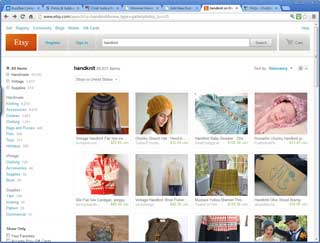
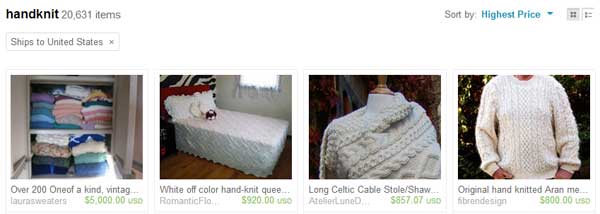
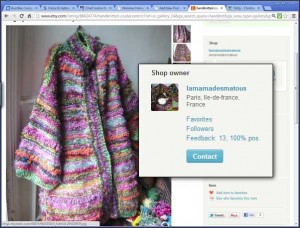
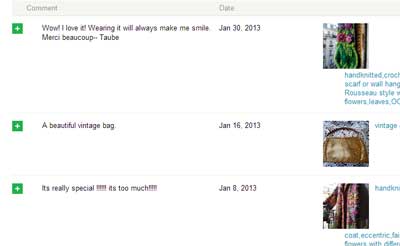
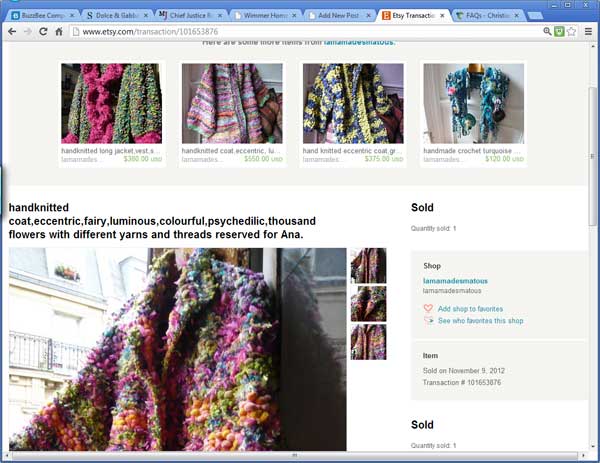



Thank you for these two blogposts. Great information and a great app. Having had a knitting business thirty+ years ago, I found out the hard way a couple times that I didn’t charge what garments were worth. And I resented it!
Thanks for your latest blog. Definitely food for thought. I’m going to “mine” etsy as well and then tweak my shop and prices accordingly.
~Best Regards~
The problem I run into with my Etsy store, is so far I’ve been forced to purchase my materials mainly from local yarn stores. Most wholesalers simply aren’t interested in selling to me at cost, either because I don’t have “a physical retail location” or due to my inability, or lack of desire, to purchase from them in the very large quantities they require. (Which would ultimately limit the variety of my designs, since everything would be made from the same type and color/s of yarn.)
Consequently, how this affects me as a designer/seller is I’m unable to create enough goods to sell in my Etsy shop and make enough profit from goods I’ve created in order to purchase new materials. I’m then forced to compete with other Etsy sellers who are selling their items for peanuts. I just can’t see how they’re making any profit whatsoever. I’m making very little profit at all.
I do not want to become a one-woman sweat shop manufacturing the same goods over and over, that buyers expect to pay very little for due to the Targets and Home Goods mentality out there. If I wanted to do that, I’d move to Peru or Nepal and knit just for the money like the men and women in the villages.
I have tried selling my items at higher prices. That gets buyers to look at my shop, but what they actually buy (generally speaking) are the lower priced items. I use Etsy to (hopefully) get word out into cyberspace that I (and my talents) exist. I wonder if the Martians ever feel as frustrated…lol!
Thank you so much for this blog post! I happened upon it and it was so helpful to see your process for researching. I’ve just recently opened an Etsy shop and I’m trying to research what sells but I have a bit of a “look! Squirrel!” syndrome where I get distracted to easily by all of the fun and beautiful stuff out there. Your system will be so helpful.
Oh, I liked reading this! And the post before it. I’ve had such problems trying to sell my crafts, I’ve gotten to a point where I only sell to people on my facebook, and even then I get people who disappear in the midst of negotiations, or flake on paying once the item is complete!
My best client knows how to knit and crochet but lacks the skill and time to do a lot of things. So she has a few shawls I’ve made, socks for her children, and other weird things. Right now I’m making her a hat that is similar in style to all the funky, easy to sell at high prices items you mentioned. Lots of texture and all the jewel colors under the sun, hahaha.
Sometimes I knit at the library after getting books, it’s a lot more calm than my house since I’ve got three kids. And while I’m used to comments from folks (I’ve been knitting or crocheting in public for years) I really get irritated at the folks who talk about how I should sell my stuff. Or ask if they can buy my piece. “Wow, I’d pay like, $15 for those socks! They’re really pretty!” Yeah, lady? It’s an interesting colorwork design I’m making up as I go with Koigu. Just the yarn is about twice that price.
I appreciate the sentiment, and I try and gently explain why I’m not selling my half finished project to them in the future, but it’s frustrating as hell when they get mad. Etsy sellers pricing their work lower than the material cost drive me up the wall because they’re making people assume that the folks actually wanting to make -some- profit are trying to rip them off.
I have just recently taken up crochet again now having found extra time. I find myself thinking of one person as I work an item. I made a prayer shawl for a friend that was going through a trying time, a poncho – hat – muff set for a niece and a collection of assorted throws and afghans for my adult children. I find crocheting to be better than any of the medicinal routes I have traveled, it calms me and I find it quite therapeutic. Especially when working with colorful and textured yarns. While I may be thinking of a particular person while I am creating it, that doesn’t always mean the person will receive the finished work. It’s more like I am drawing from their person or personality and revisiting memories. The prayer shawl mentioned above is going to a fellow crafter so I know it will be loved and my niece absolutely adores the set.
That said; I find it very difficult to even consider giving up a completed item. It’s like I have this connection to the finished work that I don’t want to let it go. I can’t imagine some of the “potential recipients” appreciating the time, thought and cost that I put into an item. In my minds eye I see it carelessly laying on a floor or hidden in a closet or… *shudders* tossed away:(
I started thinking that maybe if I put a cost on it and sold it that I would find someone who would be willing to pay a price that would insure it be appreciated as the creation of it intended. So I looked to Etsy and started doing some research.
I was appalled that someone could sell a throw or shawl for 80$ when I knew the cost of yarn had to of been more than half. It depressed me to think these beautiful things created by loving hands were being treated so cheaply. If that is all someone would pay then certainly my worst fears would be true and after a short time my beautiful item would be carelessly tossed aside.
My husband thinks I am crazy as I just create and fill “space bags” with these finished beautiful things. He does however realize it is a passion to me and respects the time I put into them (not to mention, he likes the calm;). He just doesn’t “get” the attachment I feel and thinks I should sell them for whatever I could get.
After reading a lot of these posts I think that maybe I WILL try to put a few items on Esty at prices I know will be a lot higher than the norm but will appease me and hopefully insure that the item is appreciated as intended. After all; I suppose if they don’t sell, I still have plenty of space bags and storage… right?
If you’re spending money on supplies, just to make things that you’re going to put away… at some point, any money that you can get out of the things you make is a good thing. Obviously, you want to price your work so that it gets bought by someone who falls in love with it & can’t live without it – rather than by someone who’s just looking for a schmancy picnic blanket – but it doesn’t make any sense for you to spend time & money making beautiful things that just end up taking up space in your attic. Art is meant to bee seen.
This inhgsit’s just the way to kick life into this debate.